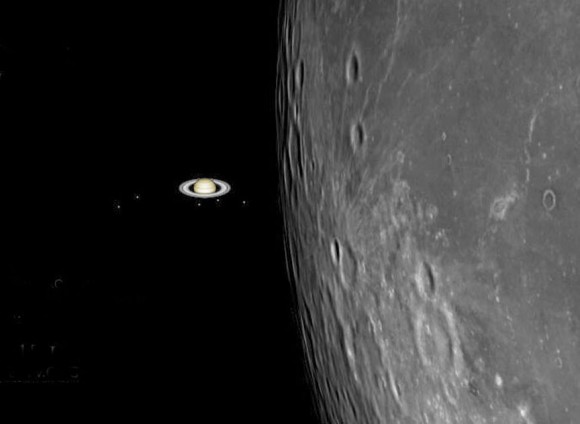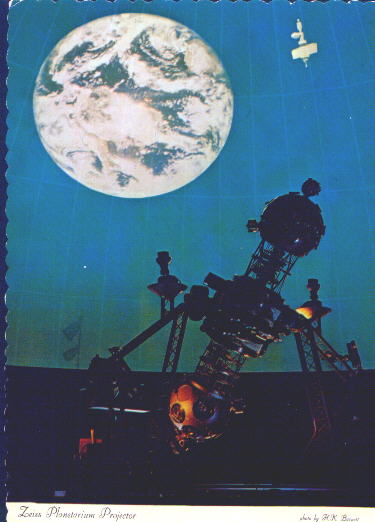
Simulation of Saturn about to be occulted, when the Moon completely obscures the view of the
ringed-planet Wednesday morning, viewable in Australia and New Zealand or on the Internet.
(Image Source: UniverseToday.com )
By Glenn A. Walsh
Reporting for SpaceWatchtower
Wednesday morning there will be the occultation of the ringed-planet Saturn by a nearly Full Moon. This event will be visible in Australia and New Zealand, but also can be seen on the Internet at this link:
The Virtual Telescope Project 2.0: Link >>> http://www.virtualtelescope.eu/webtv/
The Internet web-cast will begin on Wednesday morning (2014 May 14) at 6:15 a.m. EDT / 10:15 Coordinated Universal Time.
An occultation occurs when a closer object completely covers or obscures a more distant object. The Moon, being so close and so large in our sky, often occults stars and occasionally planets. However, occasionally a planet can also occult a star.
When a star is occulted, the star disappears in an instant, and then reappears in an instant, as the star appears as a pin-point of light due to its great distance from the Earth. However, when a much closer planet such as Saturn, with its wider ring system, is occulted, it takes a little more time for the Moon to completely obscure the planet and rings. This is what will make this occultation more interesting for viewers.
More information from UniverseToday.com :
Link >>> http://www.universetoday.com/111836/saturn-disappears-behind-the-full-flower-moon-may-14-watch-it-live/
Source: Glenn A. Walsh, Reporting for SpaceWatchtower, a project of Friends of the Zeiss.
2014: 75th Year of Pittsburgh's Buhl Planetarium

Want to receive SpaceWatchtower blog posts in your inbox ?
Send request to < spacewatchtower@planetarium.cc >..
gaw
Glenn A. Walsh, Project Director,
Friends of the Zeiss < http://buhlplanetarium.tripod.com/fotz/ >
Electronic Mail - < gawalsh@planetarium.cc >
About the SpaceWatchtower Editor / Author: < http://buhlplanetarium2.tripod.com/weblog/spacewatchtower/gaw/ >
SpaceWatchtower Blog: < http://spacewatchtower.blogspot.com/ >
Also see: South Hills Backyard Astronomers Blog: < http://shbastronomers.blogspot.com/ >
Barnestormin: Writing, Essays, Pgh. News, & More: < http://www.barnestormin.blogspot.com/ >
SPACE & SCIENCE NEWS, ASTRONOMICAL CALENDAR:
< http://buhlplanetarium.tripod.
Twitter: < https://twitter.com/spacewatchtower >
Facebook: < http://www.facebook.com/pages/
Author of History Web Sites on the Internet --
* Buhl Planetarium, Pittsburgh:
< http://www.planetarium.
* Adler Planetarium, Chicago:
< http://adlerplanetarium.
* Astronomer, Educator, Optician John A. Brashear:
< http://johnbrashear.tripod.com >
* Andrew Carnegie & Carnegie Libraries:
< http://www.andrewcarnegie.
* Civil War Museum of Andrew Carnegie Free Library:
< http://garespypost.tripod.com >
* Duquesne Incline cable-car railway, Pittsburgh:
< http://inclinedplane.tripod.
* Public Transit:
< http://andrewcarnegie2.tripod.
I think if we settle on the moon, we will experience planets and stars watching differently! They may appear larger and more detailed in our normal vision! My wish if there is a telescope that could be built over there.
ReplyDelete